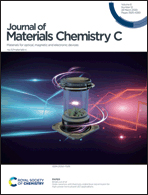Enhanced light extraction from organic light-emitting devices through non-covalent or covalent polyimide–silica light scattering hybrid films†
Abstract
In this work, two polyimide/silica composites were prepared via physical blending (A series) and chemical bonding (B series) and compared for light extraction from organic light-emitting devices (OLEDs). In the physical blending process, the hybrids were prepared from the corresponding poly(amic acid) (PAA) and tetramethyl orthosilicate (TMOS) by thermal imidization and sol–gel processes. In contrast, in the chemical bonding process, a series of hybrids were prepared using (3-aminopropyl)triethoxysilane (APTES) as a coupling agent followed by sol–gel and thermal imidization processes. Their optical, thermal, and morphological properties were investigated. The well-dispersed B series hybrid films showed higher optical transparency and lower haze characteristics than A series hybrid films. Furthermore, the scattering behavior was apparent as the silica content increased. They also exhibited high thermal stability with Td (5% weight loss temperature) higher than 510 °C. Finally, these hybrid films were applied into OLEDs. The external quantum efficiency (EQE) of all devices employing the hybrid films on the viewer's side of the substrate as the outcoupling layer increased as the silica content increased. For the OLED utilizing A3 (26 wt% of silica content), an increase of 21% in the light extraction efficiency was achieved.



 Please wait while we load your content...
Please wait while we load your content...